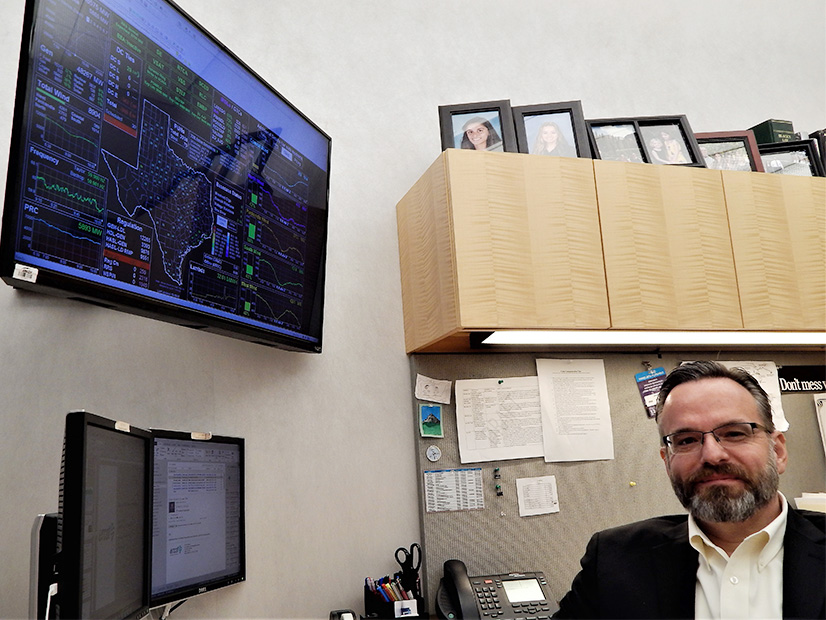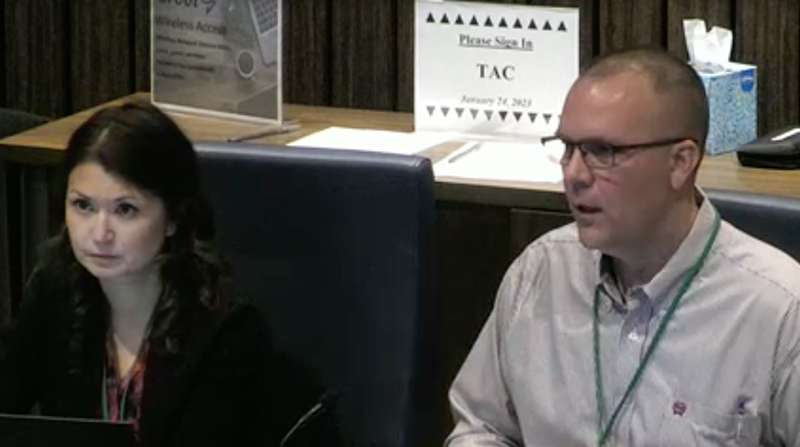
Staff Working to Understand Forced Outages in December Storm
ERCOT told its stakeholders last week that it is gathering information from its generators about the high number of outages during the December winter storm.
Staff told the Technical Advisory Committee during its Jan. 24 meeting that they have sent requests for information and its weatherization teams to generator resources that suffered forced outages during the Dec. 22-24 event. Thermal outages peaked around 13 GW, and gas supplies were again curtailed as an unwelcome reminder of the deadly February 2021 winter storm that killed hundreds of Texans and caused billions in economic damages. (See “ERCOT: December Storm ‘Non-event’,” PUC Closes in on ERCOT’s Market Redesign.)
Dan Woodfin, vice president of system operations, promised a more comprehensive report, saying staff are combining the information from the RFIs and will analyze the more detailed information.
Saying that ERCOT’s outage scheduler tends to understate outages, Independent Market Monitor Carrie Bivens asked Woodfin whether staff intended to do a true-up with telemetered values.
“Our intention is to look at telemetry and values, the outage scheduler and the results of the RFI, and kind of put it all together,” he said.
ERCOT’s preliminary analysis found gas restrictions in North Texas and operational flow orders issued to prevent gas flowing beyond contract maximums resulted in some curtailments and generation capacity. It also found that reduced renewable generation was not a large factor during the event.
Load peaked at 73.96 GW on Dec. 23, a 16-GW increase from ERCOT’s previous December record. The grid operator’s models projected a nearly 71-GW peak as the storm approached. Woodfin said other grid operators had similar problems predicting load, but that ERCOT’s miss had little effect on market reliability.
NRG Energy’s Bill Barnes took exception to the remark.
“You’re always going to get some type of market response based on ERCOT’s forecast. We look at it as a really big input into our decision-making,” he told Woodfin. “When there’s an under-forecast, that will probably result in a lower offer into the day-ahead [market], which is an economic commitment, which would mean you would have to take other additional [out-of-market] actions. The response that you get from the market? A lot of that comes from … what you guys think.”
Staff plan to engage with TAC’s Wholesale Market Subcommittee on the forecast error.
ERCOT deployed nearly 2.7 GW of its new firm fuel supply service (FFSS) Dec. 22-25 during the event. However, it failed to notify all market participants of the deployment or recall, as required under its protocols, and staff made system changes in January to correct the error.
Staff are drafting new protocols to improve existing language as they prepare for the next FFSS obligation period later this year. The changes are expected to improve the process for approving or instructing the restocking of fuel; offer disclosure reporting; incorporate an alternative FFSS resource concept; and improve qualified scheduling entities’ (QSEs) process for FFSS testing.
RUCs Continue to Increase
ERCOT staff’s annual report on reliability unit commitments led some stakeholders to call for market-based solutions after a second consecutive year of heavy RUC usage.
The grid operator said 8,244.8 instructed RUC resource-hours in 2022 resulted in 7,910.5 effective hours. That was up from the 3,853.1 effective resource-hours in 2021 and a significant increase from the two years prior, when a total of 421.8 effective resource-hours were deployed.
The increased usage is a result of ERCOT’s reliance since the 2021 winter storm on a conservative operations posture that maintains more reserves sooner. Bivens told lawmakers last year that the practice could add more than $1 billion to customers’ bills in 2022.
“We have a giant increase in RUCing some really old generators,” David Kee, CPS Energy’s director of energy market policy, told staff. “It’s causing some concerns in my shop, and we’re thinking about what we’re doing to these generators. … We’re basically running them into the ground. The more you lean on these generators and bring them online for reliability reasons, you’re going to find they’re going to break.”
ERCOT’s Dave Maggio said the average age of RUCed units was between 40 and 60 years. More than 87% of the effective resource-hours addressed capacity concerns, with 12.9% needed for local thermal congestion or voltage concerns; all of 2020’s RUCs were used to meet local congestion or voltage issues after a hurricane damaged transmission facilities in the Rio Grande Valley.
Pressed on staff’s “desire” to reduce RUCs, Kenan Ögelman, vice president of commercial operations, agreed there is a “potential better approach to procuring coverage for the uncertainty that we are dealing with.”
Ögelman said the grid operator expects to continue conservative operations but will be “looking at” modifications or improvements to RUCs. A long-term, market-based solution focused on revenue adequacy resides at the Public Utility Commission, he said, but priorities have yet to be established.
ERCOT paid out $34.11 million in RUC make-whole payments last year that was almost exclusively covered by capacity-short charges. It also clawed back $24.85 million. Those numbers were $404,000 and $484,000 in 2020, respectively.
Staff also said the delayed real-time co-optimization (RTC) project will be brought before the Board of Directors in June after they perform due diligence on the market mechanism favored by the Independent Market Monitor and many market participants.
ERCOT’s Matt Mereness said the project, put on hold almost two years ago after the 2021 winter storm, still has a $51.6 million budget line item and a three-and-a-half-year timeline “because we haven’t revisited it.”
The RTC tool would expand ERCOT’s real-time market by clearing energy and ancillary services every five minutes, as most other grid operators already do. The PUC in 2018 directed ERCOT to add RTC in 2018; it opened a rulemaking in December 2020 for its implementation (51588).
The project’s impact analysis will have to be revisited because of inflation’s toll. Staff will also reassess its scope with an eye of resuming RTC work in July.
“From a reliability perspective, it’s the next thing that we really do need,” Mereness said. “We’re not blind to the risk of this project of getting going, but we also know that we need to move forward on it. The reality is there are things going on at the commission. As that work [for ERCOT] comes out, it will have to be prioritized with other work.”
Subcommittee to Charter Credit Group
TAC delegated the soon-to-be-disbanded Market Credit Working Group (MCWG) to develop a proposed charter, structure and name for a new working group that will report directly to the committee. The group will then replace the MCWG, which had provided input on credit-risk management issues to TAC’s Wholesale Markets Subcommittee.
The stakeholder group will give market participants a voice in market credit issues after the board’s Reliability & Markets Committee determined that staff should report to it on credit issues, and it moved in December to disband the Credit Working Group (CWG). The group was shifted last year to the R&M’s purview from the Finance & Audit Committee, where it had been since 2004. (See “ERCOT Gets 1st Adjunct Member,” ERCOT Board of Directors Briefs: Dec. 19-20, 2022.)
Speaking for Reliant Energy Retail Services, Barnes, a regular CWG attendee, pushed for the new group to include credit professionals, saying his company’s credit pro recommended a voting structure. Other members stressed the importance of market diversity within the group.
The new group’s responsibilities will likely include a credit review of all future nodal protocol revision requests, as required by NPRR1157 and formerly carried out by the CWG.
TAC Elects 2023 Leadership

Committee members re-elected by acclamation South Texas Electric Cooperative’s Clif Lange as their chair for 2023. Having recently been promoted as the cooperative’s general manager, Lange has asked that TAC meetings be moved to Tuesdays this year.
Members also elected Jupiter Power’s Caitlin Smith as vice chair. American Electric Power’s Richard Ross also ran for the position.
The committee’s 2023 subcommittee leadership was approved as part of the combination ballot:
- Protocol Revision Subcommittee (PRS): Martha Henson (Oncor) as chair and Diana Coleman (CPS Energy) as vice chair.
- Retail Market Subcommittee: Deborah McKeever (Oncor) as chair and John Schatz (Luminant) as vice chair.
- Reliability and Operations Subcommittee: Chase Smith (Southern Power) as chair and Katie Rich (Golden Spread Electric Cooperative) as vice chair.
- Wholesale Market Subcommittee: Eric Blakey (Pedernales Electric Cooperative) as chair and Jim Lee (CenterPoint Energy) as vice chair.
Most of the leadership are holdovers, with McKeever and Schatz switching positions. Coleman, Blakey and Lee are all new to their roles.
Members Endorse Five NPRRs
TAC unanimously approved NPRR1144, which provides a limited exception to the requirement that loads included in an ERCOT-polled settlement (EPS) metering facility’s netting arrangement only be connected to the grid through the facility’s metering point(s). The exception would allow no more than 500 kW of auxiliary load connected to a station service transformer be connected to a transmission or distribution service provider’s (TSP/DSP) facilities through a separately metered point using an open transition load transfer switch listed for emergency use.
The measure passed 29-0, with CenterPoint abstaining.
TAC unanimously endorsed four other NPRRs on a combination ballot with a change to the Planning Guide (PGRR) that, if approved by the board, would:
- NPRR1147: set fast frequency response’s ancillary service offer floor 1 cent/MW lower than other responsive reserve services categories to allow FFR’s procurement up to the current limit, without proration with other categories.
- NPRR1149: charge QSEs an ancillary service failed quantity if their supply responsibility is not met in real time by their portfolio’s resources, based on a comparison of their real-time telemetry.
- NPRR1151: eliminate the protocol requirement that the PRS hold at least one meeting per month.
- NPRR1153: add two existing fees (public information request labor and ERCOT training) to the grid operator’s fee schedule; create a $500 registration fee for resource entities, TSPs and DSPs, and subordinate QSEs; delete the system administration fee’s current value and the map sales fee; and restructure existing fees for generator interconnection or modification, full interconnection study applications and wide area networks.
- PGRR102: require resource entities and interconnecting entities to provide operations dynamic model quality test results that demonstrate appropriate performance for submitted operations dynamic models, and make non-substantive clarifying changes.



